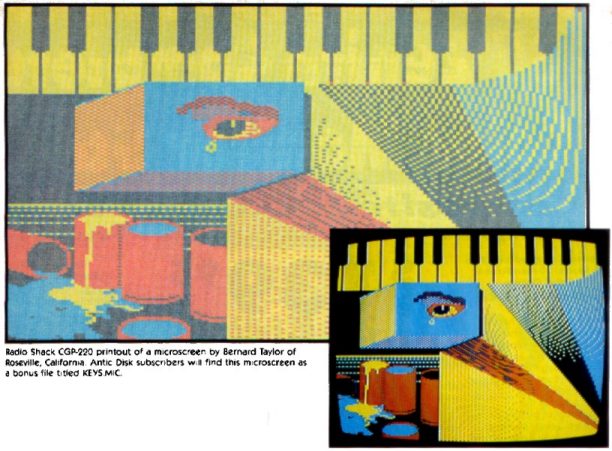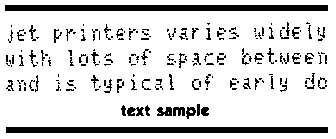RADIO SHACK COLOR PRINTER MEETS ATARI
Best color printing under $1,000?
By Stan and Suzi SubeckThis article reviews the Radio Shack Color Inkjet Printer and describes how to use it with the Atari. Included is a program that prints standard Micro-Painter graphics flies as color screen dumps in Graphics Mode 7.5. This BASIC program works on all 8-bit Atari computers of any memory size, with disk or cassette.
Do you want the best multicolor printing available for the Atari – as well as highly readable correspondence quality text? We're afraid you'll have to think about spending $699 on a Radio Shack CGP-220 Color Graphics Printer.
Sure, $699 is a lot of money. But the Subeck family is glad we convinced ourselves the CGP-220 is a bargain and we have thoroughly enjoyed owning ours. Canon, the actual manufacturer, markets the identical printer under its own label for $799. Canon also produces it for Quadram, who markets it as "IBM compatible" for $899. Anyway, until recently you couldn't come close to this level of color printing without spending several thousand dollars.
(If you would like to compare the CGP-220 to its nearest competitors, please refer to the March, 1985 Antic article, New Color Printers, which review's the $208 Okimate 10 and the $599 Seikosha GP-700A. These printers cost a lot less than the Radio Shack entry and predictably they deliver a lot less, although the Oki is a good value at its current price when used with RAMbrandt software, $19.95 from the Antic Catalog – ANTIC ED)
As you can see from the sample illustrations on these pages, this color printer delivers genuinely beautiful screen dumps. Our daughter Lisa made big bucks selling her classmates book covers imprinted with the names of rock groups like Duran Duran and Wham for 25 cents apiece.

THE PROGRAM
Stan wrote a simple BASIC printer driver that accompanies this story. The program prints standard MicroPainter graphics files as Graphics Mode 7.5 color screen dumps.
The CGP-220 Screen Dump is written in BASIC. When ran, it will generate the necessary machine code to speed up the print-out time. Type in Listing 1, check it with TYPO II and SAVE a copy before you RUN it.
COLOR INK JET
The CGP-220 is an ink jet printer like the Hewlett-Packard Thinkjet that Antic reviewed in the March 1985 Printer Issue. However, this Radio Shack printer uses four ink colors to reproduce as many as 25 colors in a single graphics dump.
As usual, since the CGP-220 is a third-party product, it does require a Centronics parallel printer interface. The Atari 850, the MPP MicroPrint and the ATR-8000 all seemed to work quite well.
Ink jets work by actually squirting a small quantity of ink from a reservoir through a tiny hole onto the page. (A special high-absorbency paper is recommended.) The actual image depends on the timing and distance between squirts. Just like dot matrix printers, ink jets can reproduce text and graphics.
The CGP-220 uses two ink cartridges – black and tri-color – that will each print as many as 4 million characters. The cartridges are easily replaced from the front of the printer. The tri-color cartridge costs $14.95 and contains the primary colors – cyan, yellow and magenta. Mixtures of these colors produce red, green, blue, yellow, magenta and violet. The $9.95 black cartridge can be used for borders between colors or for correspondence quality text.

The text sample printed here is in straight draft mode. The CGP-220 also has an enhanced density mode that creates darker letters. Standard text characters are formed as a 5 x 7 dot matrix, through seven passes of the single ink-jet nozzle. (Antic clocked the text printing speed of the CGP-220 at a rather slow 26 characters per second. – ANTIC ED) The printer's slowness is partially compensated for by its incredible silence. You could hear a whispered conversation while this machine is operating.
The text mode supports the standard ASCII character set, CHR$(32) to CHR$(127), as well as a 64-character European set, CHR$(160) to CHR$(223). Characters may be printed in either standard size or double width.
COLOR MODES
In the first of the two graphics modes, known as the bit image mode, 640 columns of seven dots each may be printed across a page. Any of the seven dots is printable, and each column can be in one color. Because this mode is essentially the same as that which is used by the Epson, currently available screen dumps require no more than minor conversions to produce clear, single color prints.
The second graphics mode is the Color Scan. This mode affords greater flexibility in color mixing. Printing is based on horizontal rows of eight dots, in which each dot may be a different color. By using the proper shading, virtually any color may be produced. High resolution screen dumps are possible in this mode, by using RGB mixing in a manner similar to that which is used by television monitors.
The CGP-220 accepts paper either in rolls or single sheets. Despite the lack of a tractor feed, there is no problem with paper slippage. The paper roll is conveniently top-mounted under a hinged dust cover. The printer supports line feeds of 1/6-inch and 1/8-inch. It can also tab to any of 360 dot positions on a line.
The accompanying manual is 50 pages of straightforward technical information that's accurate and easily understood. The CGP-220 supports only 14 different control codes, so a complicated instruction manual is not necessary. However, don't expect to find any specific Atari information included.
RADIO SHACK CGP-220 Tandy Corporation 1700 One Tandy Center Fort Worth, TX 76102 (817) 390-3300 $699This is Stan Subeck's first published program in Antic. However Suzi "Call Me Modem" Subeck is a familiar name to readers of this magazine.
Listing 1: CGP220.BAS Download
Bonus image: KEYS.MIC Download